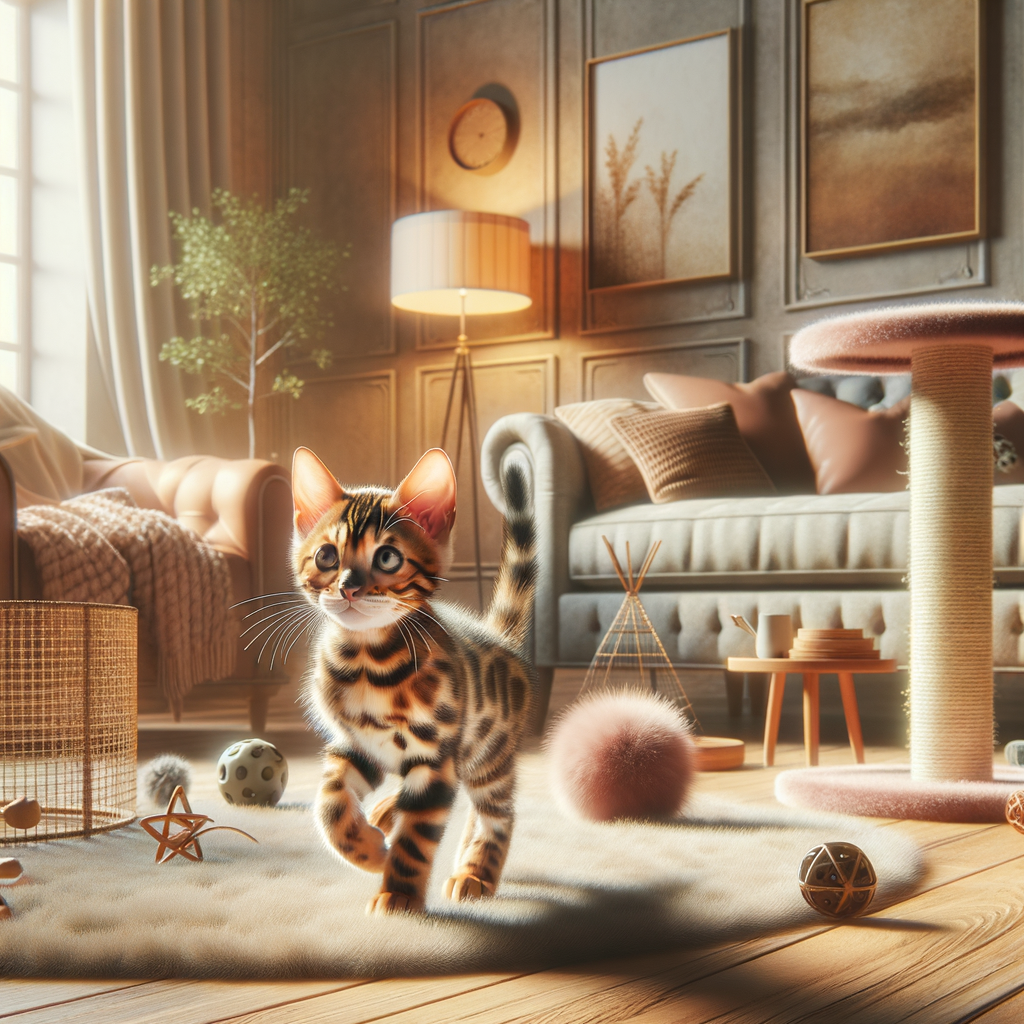
Introduction to Raising a Bengal Kitten
-
What is a Bengal kitten?
A Bengal kitten is a breed of domestic cat that looks like a wild leopard. They have beautiful, spotted coats and are known for their playful and energetic nature. Bengals are a mix of the Asian leopard cat and domestic cats.
-
Why choose a Bengal kitten?
Bengal kittens are unique and full of personality. They are very active and love to play. If you are looking for a cat that is both beautiful and fun, a Bengal kitten might be the perfect choice for you.
- Active and Playful: Bengals love to run, jump, and climb.
- Intelligent: They are very smart and can learn tricks.
- Affectionate: Bengals enjoy spending time with their owners.
-
Bengal kitten behavior
Bengal kittens are known for their high energy levels. They need lots of playtime and mental stimulation. Without enough activity, they can become bored and may get into trouble.
Here are some key behaviors to expect:
- Curiosity: Bengals are very curious and love to explore their surroundings.
- Vocal: They often communicate with their owners through meows and other sounds.
- Social: Bengals enjoy being around people and other pets.
Bengal Kitten Care
Bengal Kitten Diet
- The nutritional needs of a Bengal kittenBengal kittens have specific nutritional needs to support their rapid growth and high energy levels. They require a balanced diet rich in proteins, fats, vitamins, and minerals. Proteins help build strong muscles, while fats provide energy. Vitamins and minerals are essential for overall health.
- Best food for Bengal kittensHigh-quality kitten food, either wet or dry, is recommended. Look for brands that list meat as the first ingredient. Avoid foods with artificial additives or fillers. Some popular brands include Royal Canin and Hill’s Science Diet.
Brand Type Main Ingredients Royal Canin Dry Chicken, Rice, Corn Hill’s Science Diet Wet Chicken, Liver, Fish Oil -
Feeding schedule for Bengal kittens
Kittens typically need to eat 3-4 times a day. As they grow older, you can reduce the frequency to 2-3 times a day. Always provide fresh water and monitor their weight to ensure they are growing properly.
Bengal Kitten Health
-
Common health issues in Bengal kittens
- Hypertrophic Cardiomyopathy (HCM): A heart disease that can affect Bengal kittens.
- Progressive Retinal Atrophy (PRA): An eye condition that can lead to blindness.
- Feline Infectious Peritonitis (FIP): A viral disease that can be serious.
-
Importance of regular vet check-ups
- Check for any signs of illness or disease.
- Monitor your kitten’s growth and development.
- Provide advice on diet and care.
-
Vaccinations and deworming
- Rabies
- Feline Distemper
- Feline Herpesvirus
- Feline Calicivirus
| Health Aspect | Details |
|---|---|
| Common Health Issues | HCM, PRA, FIP |
| Vet Check-ups | Every 6 months |
| Vaccinations | Rabies, Feline Distemper, Feline Herpesvirus, Feline Calicivirus |
| Deworming | Roundworms, Tapeworms |
Bengal Kitten Training
Litter Training
- Best age to start litter training:The best age to start litter training a Bengal kitten is around 4 weeks old. At this age, kittens are beginning to explore their surroundings and can start learning new habits.
- Steps to litter train a Bengal kitten:
- Step 1: Choose the right litter box. Make sure the box is shallow enough for the kitten to easily climb in and out.
- Step 2: Select the right litter. Use a non-clumping, unscented litter to avoid any health risks.
- Step 3: Place the litter box in a quiet area. Kittens need a calm environment to feel comfortable using the litter box.
- Step 4: Introduce the kitten to the litter box. Gently place the kitten in the box after meals and naps to encourage use.
- Step 5: Praise and reward. When the kitten uses the litter box, offer praise and a small treat to reinforce the behavior.
-
Dealing with litter box issues:
- Keep the litter box clean. Scoop out waste daily and change the litter regularly.
- Check for health problems. If your kitten avoids the litter box, it could be due to a medical issue. Consult your vet.
- Try different litter types. Some kittens prefer certain textures or scents. Experiment to find what works best.
- Limit access to other areas. Keep your kitten in a smaller space with the litter box until they consistently use it.
Behavioral Training
-
Bengal Kitten Behavior
Bengal kittens are known for their playful and energetic nature. They love to climb, jump, and explore. These kittens are very curious and intelligent. They often engage in activities that might seem mischievous but are just part of their natural instincts.
Behavior Explanation Climbing Bengal kittens love to climb. It helps them exercise and stay active. Scratching Scratching helps them keep their claws sharp and mark their territory. Chasing This is a natural hunting behavior. They enjoy chasing toys or even other pets. -
How to Discourage Unwanted Behaviors
Sometimes, Bengal kittens may develop behaviors that are not desirable. Here are some tips to discourage them:
-
- Provide Alternatives: If your kitten scratches furniture, provide a scratching post.
- Use Deterrents: Safe deterrents like double-sided tape can keep them away from certain areas.
- Consistency: Be consistent with your training. Mixed signals can confuse your kitten.
-
Positive Reinforcement Techniques
Positive reinforcement is one of the best ways to train your Bengal kitten. This means rewarding good behavior rather than punishing bad behavior.
Here are some techniques:
- Treats: Give your kitten a treat when they do something right.
- Praise: Use a happy and encouraging tone to praise your kitten.
- Playtime: Reward good behavior with a fun play session.
Bengal Kitten Socialization
- Why socialization is important for Bengal kittens
It helps them become friendly and confident. Without proper socialization, they may become shy or aggressive. According to Wikipedia, early socialization can prevent behavioral problems later in life.
- How to socialize your Bengal kitten with other pets
Introducing your Bengal kitten to other pets should be done gradually. Start by allowing them to sniff each other through a closed door. Then, let them meet in a controlled environment. Always supervise their interactions. Reward both pets with treats for good behavior. This helps them associate each other with positive experiences.
- Introducing your Bengal kitten to new people
When introducing your Bengal kitten to new people, take it slow. Let your kitten approach at their own pace. Ask visitors to sit quietly and offer treats. This makes your kitten feel safe and encourages them to be social. Over time, your kitten will learn that new people are not a threat.
Bengal Kitten Grooming
- How often to groom your Bengal kitten
You should brush your Bengal kitten at least once a week. This helps remove loose fur and prevents matting. Regular grooming also helps you check for any skin issues or parasites.
- Best grooming tools for Bengal kittens
Using the right tools makes grooming easier and more effective. Here are some of the best grooming tools for Bengal kittens:
-
-
- Brush: A soft-bristle brush is gentle on your kitten’s skin and helps remove loose fur.
- Comb: A fine-tooth comb is great for detangling and checking for fleas.
- Nail Clippers: Special nail clippers for cats help keep your kitten’s claws trimmed.
- Pet Wipes: These are useful for cleaning your kitten’s fur and paws.
-
-
How to make grooming a positive experience
Grooming should be a positive experience for your Bengal kitten. Here are some tips to make grooming enjoyable:
-
- Start Early: Begin grooming your kitten when they are young. This helps them get used to the process.
- Be Gentle: Use gentle strokes and avoid pulling on their fur.
- Give Treats: Reward your kitten with treats during and after grooming. This creates a positive association.
- Take Breaks: If your kitten gets restless, take short breaks and then continue.
Creating the Right Environment for Your Bengal Kitten
- Choosing the right toys for your Bengal kitten
Bengal kittens are very playful and active. They need toys that can keep them entertained and help them use their energy. Look for toys that are safe and durable. Balls, feather wands, and puzzle toys are great choices. These toys help your kitten stay active and happy.
- Creating a safe space for your Bengal kitten
Your Bengal kitten needs a safe space to feel secure. Set up a cozy area with a bed, some toys, and a scratching post. Make sure this space is quiet and away from busy areas of your home. This will help your kitten feel safe and comfortable.
- Importance of playtime for Bengal kittens
It helps them stay healthy and happy. Playing with your kitten every day can also help you bond with them. Try to spend at least 15-20 minutes each day playing with your kitten. This can include chasing toys, playing with feather wands, or even teaching them new tricks.
| Key Points | Details |
|---|---|
| Choosing the right toys | Safe, durable toys like balls, feather wands, and puzzle toys |
| Creating a safe space | Cozy area with a bed, toys, and a scratching post |
| Importance of playtime | At least 15-20 minutes of playtime each day |
Enjoying Your Time with Your Bengal Kitten
- The commitment of raising a Bengal kitten: Bengal kittens require time, attention, and care. They need regular feeding, grooming, and playtime. Make sure you are ready for this responsibility before bringing one home.
- Enjoying the rewards of raising a Bengal kitten: Despite the commitment, the rewards are plentiful. Bengal kittens are affectionate and can form strong bonds with their owners. They are also very intelligent and can be trained to do tricks. Watching them grow and develop is a joy.
Raising a Bengal kitten is a rewarding experience that requires dedication. If you are prepared for the commitment, you will find that these beautiful and intelligent cats make wonderful companions.






